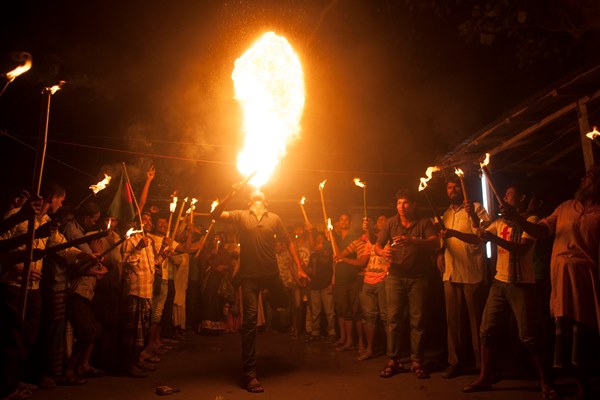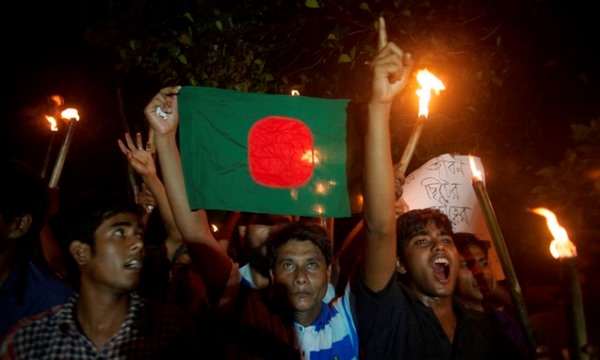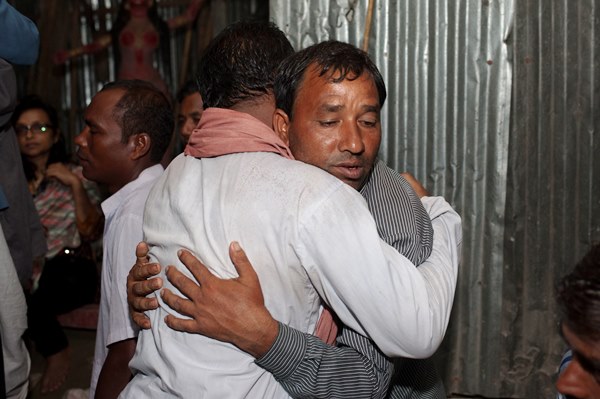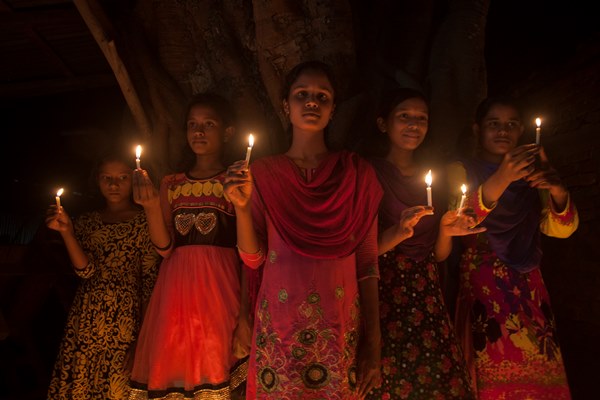 At the beginning of this month, Mubashar Hasan visited an Indian enclave as it officially became part of Bangladesh following the Land Boundary Agreement signed two months ago. Speaking to people who had been stateless their whole lives, he finds that Bangladeshi citizenship holds multiple meanings for former enclave residents. Photos by Suvra Kanti Das.
At the beginning of this month, Mubashar Hasan visited an Indian enclave as it officially became part of Bangladesh following the Land Boundary Agreement signed two months ago. Speaking to people who had been stateless their whole lives, he finds that Bangladeshi citizenship holds multiple meanings for former enclave residents. Photos by Suvra Kanti Das.
As the clock struck midnight on August 1 2015, India and Bangladesh exchanged control of some 162 pockets of land formerly known as enclaves. The move was branded as akin to the fall of the Berlin Wall by politicians and was a product of the Land Boundary Agreement signed by the Bangladeshi Prime Minister Sheikh Hasina and Indian Premiere Modi in June this year.

An enclave is a piece of territory surrounded by another state. Until 1 August about 50,000 people were living in 111 Bangladeshi and 51 Indian enclaves on the Indo-Bangla border, cut off from their parent nations. Everyday routines such as visiting the market were cumbersome processes because they involved crossing national boundaries. To enter Bangladesh, a resident in an Indian enclave would need a visa. However, actually getting a visa was virtually out of the question because passports were not issued to enclave inhabitants so they were not recognised as citizens on India. Temporary passes were issued to address the mobility issue but this was not an adequate long-term solution.
While the states could assert sovereignty over their enclaves, and exerted the power to exclude residents from citizenship, they denied responsibility for the inhabitants. As a result, residents were rendered stateless and ineligible for state support and public services. The enclaves fell outside state jurisdiction, leading to high crime rates and little prosecution. Even now it will take time to address the lack of basic facilities, infrastructure and access to electricity. As a whole, enclaves were left outside of the political imaginaries of the modern nation states for over half a century.
It was therefore no wonder that enclave residents were ecstatic on the early morning of 1 August as they became part of state and with access to associated benefits. The link between territory, state and individual was finally made a reality. In order to observe the process of state formation within an enclave and understand how a modern nation state is perceived by individuals, the Bangladesh Institute of Social Research Trust conducted an ethnographic study in Dashiarchara, a former Indian enclave situated near the Indo-Bangla border in the Kurigram district of Bangladesh, home for 7,500 people.

A brief history
The enclaves along the India-Bangladesh border came into existence through a treaty between two former princely states in 1793. In 1947, at the time of the partition of British India, those enclaves were not accounted for in the territorial boundaries of India and Pakistan because they were not part of the British Empire.
In 1958, leaders of Pakistan and India signed an agreement to resolve border disputes but that agreement did not bring any meaningful change for the people living in enclaves. Following the independence of Bangladesh in 1971, another agreement was signed between Sheikh Mujib Rahman and Indira Gandhi. However, nationalist sentiment continued to cloud the judgment of policy-makers in both countries and India never ratified the treaty. The 2015 agreement between Hasina and Modi was therefore a game changer and the hand over this month marked the end of an anachronistic and yet persistent dispute.
Formation of the State

In order to mark the state formation process, inhabitants of Dashiarchara and visiting local Bangladeshi politicians hoisted the national flag of their new parent nation. Flags are a widely used tool in the reproduction of the imaginaries of the modern nation states and the arrival of Bangladeshi flags in Dashiarchara marked a decisive identity shift. Many were seen shouting slogans like: Delhi na Dhaka? Dhaka, Dhaka! (Delhi or Dhaka? Dhaka, Dhaka) and Ar noy Chitbashi-Amra shobai Bangladeshi in Bangla (We are no more the inhabitants of enclaves we all are Bangladeshis) underpinning the recognition of that moment when an official relationship was established between the Bangladeshi state, expanded territory and individuals. Hindus were seen singing devotional songs known as Kirton while Muslims prayed in local mosques to mark the special day.

Understandings of the State
When the new Bangladeshi citizens were asked about the meaning of the state, they gave four categorical answers. Firstly, state represents an authoritative body with the power to issue legal documents for availing basic amenities like education, health care, freedom of movement and so forth. It is worth quoting Mohammed Omar Faruk, a 35 year old local trader who was a resident of Dashiarchara, who said, “its not that my children are illiterate, we have made false identities to send my children to nearby Bangladeshi schools where we used false addresses, now we would be able to avail legal documents from Bangladesh truthfully.” This practice of forging documents was found to be common practice, so the handover marked the moment where previously illegal workarounds could be achieved legally.
Secondly, state means formalising ownership over property and a framework for rule of law. Establishing the ownership over a piece of land seemed to be a matter of great concern among many. “Everybody knows that I own the land where I have been living for many years and the government have assured me full support, however, until I receive legal rights from Bangladesh to establish ownership over my land, I’m a bit tense”, said Mohammad Sajidul Huq, a 57 year man. “In the past, people were murdered here for land”, he added. Another man, Moinul Huq, who was sitting beside Sajidul in the tea stall said, “ It is a matter of great relief that rule of law has arrived to this place.” He was referring to members of Bangladeshi law-enforcement agencies who were standing nearby.

Thirdly, state means re-establishing as well as disrupting human relationships. For example, most people in Dashiarchara have relatives in the nearby villages of Bangladesh, who they were artificially separated from by living in an Indian enclave. The handover facilitates the reestablishment of social and legal ties between family members. However, in some cases families are divided, either because family members have previously left to seek employment in India or because people have chosen to leave rather than become resident of Bangladesh. Before the enclave swap residents of enclaves were given the option to choose their citizenship. Out of the approximate 50,000 people in enclaves, about 37,000 choose to adopt Bangladeshi citizenship.
Finally, state is a medium for imagination. Russel Khodker, a man in his late teens, danced to celebrate his new found citizenship. He said, “we have been living in the dark for many years, I am now part of Bangladesh, my dream came true.” Live TV coverage of new Bangladeshis celebrating at midnight and reproductions of the festivities in the papers the following day also highlighted the state adjusting to its new identity. State belonging also facilitates imagination for individuals to dream a better future. This may seem obvious to most people, but it had been obscure to a 15 year old girl Sharifa who was seen holding a candle-light to mark the moment. “Now that I am a Bangladeshi citizen, I aim to be a female political leader like our Prime Minister Sheikh Hasina, I will study hard and join politics in future” she said.

Note: This article gives the views of the author, and not the position of the South Asia @ LSE blog, nor of the London School of Economics. Please read our comments policy before posting.
About the Author and Photographer
 Mubashar Hasan is a research fellow of BISR Trust and a PhD Candidate at the School of Government and International Relations, Griffith University, Australia. He is the founder of alochonaa.com, a politics, culture and IR blog, and tweets @mubashardhaka.
Mubashar Hasan is a research fellow of BISR Trust and a PhD Candidate at the School of Government and International Relations, Griffith University, Australia. He is the founder of alochonaa.com, a politics, culture and IR blog, and tweets @mubashardhaka.
Suvra Kanti Das, born in Chandpur, Bangladesh on 1979, is a photojournalist. His photos demonstrate how life extends beyond its own subjective limits and often tells a story about the effects of global cultural interaction over the latter half of the twentieth century. You can see further examples of his work here.







